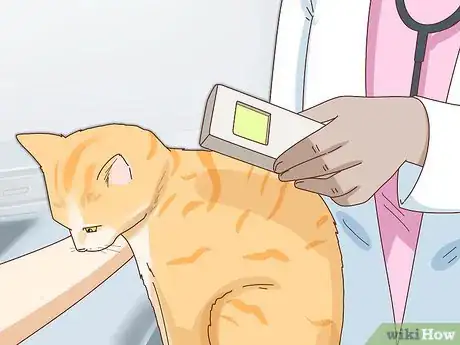This article was co-authored by Francine Miller. Francine Miller is an Applied Animal Behavior Counselor and Founder of Call Ms Behaving, a behavior counseling service for dogs and cats in San Diego, California. With over 16 years of experience, Francine specializes in treating behavior problems such as aggression, separation anxiety, phobias, fear reactions, destructiveness, urine marking, and compulsive behaviors. She uses a behavioral management and modification plan that is positive reinforcement only. She holds a Diploma in Canine Behavior Counseling from the American College of Applied Science (ACAS). Francine has completed all coursework toward an MS in Applied Animal Behavior Science and Family Counseling for Companion Animals from the American College of Applied Science (ACAS). She is a certified Associate of the International Association of Animal Behavior Consultants (IAABC) and a member of the Pet Professional Guild.
This article has been viewed 150,437 times.
Taking in a stray cat is a great way to adopt a new pet that otherwise may never have a good home. Before you decide to adopt the pet as your own, make sure that it doesn’t have an owner. If the cat doesn’t have a home, vaccinate it, treat any injuries or illnesses, and then slowly introduce it to your home. It can take a while for the cat to get used to a new environment, but the process is incredibly rewarding.
Steps
Introducing the Cat to Your Home
-
1Feed the cat outside if it won’t come inside. Stray cats are often shy and won’t come inside near people. Place a bowl of cat food outside at the same time each day. This helps to get the stray cat used to the routine.[1]
- If the cat won’t eat the food, try placing the bowl further away from the house.
- Try feeding the cat different types of food, such as cat biscuits or packets of cat food. These can be purchased from a pet store. If the cat has been on the streets for a long time, it may not be used to typical foods and will take a while to get used to its new diet.
-
2Bring the food inside once the cat is comfortable eating near the house. Place the bowl of food inside the front door and ensure that nobody is around to scare the cat. If you have any other pets in the house, lock them in a separate room for 10-15 minute while the cat eats.[2]
- Continue to feed the cat at the same time of day. This will help to increase the chances of the cat coming inside.
Advertisement -
3Shut the door behind the cat while it is eating. Close all the windows and doors in the house to stop the cat from escaping. It is likely that the cat will hide for a little while once it realises that the front door is closed. This is normal behaviour for a stray cat and overtime, it will slowly become more confident.
- If the cat makes loud noises, starts clawing at furniture, or is terrified of people, this may indicate that it is feral. In this scenario, it is best to open the door and let the cat outside.
-
4Isolate the stray cat from other pets until it is tested and vaccinated by a vet. Stray cats are often not vaccinated, which means that they can pass on diseases to other pets in the house. Keep the stray cat in a comfortable contained space with plenty of food, water, and airflow.[3] Take any items out of the room that could fall off shelves or tables and injure the cat.[4]
- Wash your hands after touching the stray cat to avoid passing on any germs to other pets in your house.
- Talk to the cat regularly while it is in an isolated room. This will help it get used to you.
- Make sure the cat has a tray of litter in the room in case they have to relieve themselves.
Making Sure It's a Stray
-
1Take the cat to a vet to check if it has a microchip. If the cat has a microchip, this means that it has had an owner at some point. Ask the vet to give you a copy of the contact details of the most recent owner of the cat or see if the vet can contact them for you. Contact the owner to ensure that they don’t want the cat and that they are happy for you to adopt it.
- A vet will typically charge around $50 for an appointment, but most will scan stray cats for free. Contact your local vet to receive a quote.
- If the cat won’t go into its carrier, place a bowl of food into the cage to tempt the cat inside.
-
2Post a picture of the cat around your neighborhood to find its owner. Take a photo of the cat and place it on a local community notice board and on social media. Write a detailed description of where you found the cat and note any distinguishing features or markings. Include your contact details on the notice so that the cat's owner can contact you.
- In many states you are legally required to take practical measures to ensure that a stray cat doesn’t have an owner before taking it in, even if the cat isn’t microchipped.
- Keep the cat inside while you look for its owner.
-
3Consider that the cat is a stray if you can’t find its owner after 7 days. If the microchip doesn't exist and the owner cannot be traced, it is safe to presume that the cat is a stray. Avoid welcoming the cat into your home until you are sure that it is a stray, as this is illegal in some localities.
-
4Ask the vet to vaccinate the cat and give it a checkup.[5] Stray cats are often unvaccinated and commonly have fleas. Ask the vet to check for fleas, worms, infections, injuries, and diseases, and to prescribe any necessary medications. Keep the cat isolated from other animals until it is free from any parasites or illnesses.[6]
- Ask the vet if the cat has been neutered.
Taming the Stray Cat
-
1Talk to the cat while you pat it to help it bond with you. Speak in a soft voice while you gently stroke the cat. Over time, the cat will get used to your voice and scent and will be less afraid of being touched. Don’t worry if the cat won’t let you touch them very often at first, this is normal behaviour for a stray cat.[7]
- If the cat won’t let you touch them, don't force it. Continue to talk softly to it until it is ready to let you stroke it.[8]
-
2Avoid eye contact with the cat to help gain its trust. Many stray cats will interpret direct eye contact as threatening. Look briefly at the cat and then close your eyes or shift your gaze away. This will help the cat to feel safe and calm in its new environment.[9]
- Over time, slowly increase the amount of eye contact that you give your cat.
- If you accidentally stare at the cat, simply shut your eyes for a few seconds and slowly turn your head away.
-
3Keep a regular feeding schedule to show the cat that you’re reliable. Feed your cat at the same time each day. This demonstrates to your cat that you are a trustworthy source of food and will help it to bond with you.[10]
- If the cat won’t eat the food you give it, try different cat food brands until you find one that it likes.
- Your cat will be calmer and less erratic with a regular feeding schedule.
-
4Introduce other pets to the cat slowly. If you have multiple pets in your home, the stray cat may feel overwhelmed. Bring 1 animal into the cat's room at a time to allow them to slowly get acquainted. Once both animals seem comfortable, introduce another animal. Continue to repeat this process until all your pets are comfortable being in the same space together.[11]
- If your other pets don’t normally respond well to new animals, place them in their carry bag for 15 minutes in the stray cat's room. This will help them to get used to each other very slowly.
-
5Let your cat outside after 3 weeks if you don’t want it to be an inside cat. This time inside allows it to bond with your family and pets and will help it to remember to return home once it is let outside. Let the cat outside on a warm dry day and ensure that it is hungry. This helps to encourage the cat to come home to eat.[12]
- If the cat is scared to go outside, walk beside it to help reassure it.
- Most vets recommend keeping the cat inside.
Expert Q&A
Did you know you can get premium answers for this article?
Unlock premium answers by supporting wikiHow
-
QuestionShould I let a stray cat into my house?
 Francine MillerFrancine Miller is an Applied Animal Behavior Counselor and Founder of Call Ms Behaving, a behavior counseling service for dogs and cats in San Diego, California. With over 16 years of experience, Francine specializes in treating behavior problems such as aggression, separation anxiety, phobias, fear reactions, destructiveness, urine marking, and compulsive behaviors. She uses a behavioral management and modification plan that is positive reinforcement only. She holds a Diploma in Canine Behavior Counseling from the American College of Applied Science (ACAS). Francine has completed all coursework toward an MS in Applied Animal Behavior Science and Family Counseling for Companion Animals from the American College of Applied Science (ACAS). She is a certified Associate of the International Association of Animal Behavior Consultants (IAABC) and a member of the Pet Professional Guild.
Francine MillerFrancine Miller is an Applied Animal Behavior Counselor and Founder of Call Ms Behaving, a behavior counseling service for dogs and cats in San Diego, California. With over 16 years of experience, Francine specializes in treating behavior problems such as aggression, separation anxiety, phobias, fear reactions, destructiveness, urine marking, and compulsive behaviors. She uses a behavioral management and modification plan that is positive reinforcement only. She holds a Diploma in Canine Behavior Counseling from the American College of Applied Science (ACAS). Francine has completed all coursework toward an MS in Applied Animal Behavior Science and Family Counseling for Companion Animals from the American College of Applied Science (ACAS). She is a certified Associate of the International Association of Animal Behavior Consultants (IAABC) and a member of the Pet Professional Guild.
Certified Animal Behavior Counselor
-
QuestionCan you domesticate a stray cat?
 wikiHow Staff EditorThis answer was written by one of our trained team of researchers who validated it for accuracy and comprehensiveness.
wikiHow Staff EditorThis answer was written by one of our trained team of researchers who validated it for accuracy and comprehensiveness.
Staff Answer wikiHow Staff EditorStaff AnswerSome stray cats have already lived with humans, so they’re already well socialized and ready to be in a loving home. If the stray hasn’t lived with humans before but is still a kitten or a very young adult, it may not take long for the cat to become friendly and tame. Older cats who aren’t used to being around humans can be a lot trickier—you’ll need to be very patient and give them lots of time to learn to trust you. Be prepared for the possibility that your new friend may never be fully socialized.
wikiHow Staff EditorStaff AnswerSome stray cats have already lived with humans, so they’re already well socialized and ready to be in a loving home. If the stray hasn’t lived with humans before but is still a kitten or a very young adult, it may not take long for the cat to become friendly and tame. Older cats who aren’t used to being around humans can be a lot trickier—you’ll need to be very patient and give them lots of time to learn to trust you. Be prepared for the possibility that your new friend may never be fully socialized. -
QuestionDo stray cats carry diseases?
 wikiHow Staff EditorThis answer was written by one of our trained team of researchers who validated it for accuracy and comprehensiveness.
wikiHow Staff EditorThis answer was written by one of our trained team of researchers who validated it for accuracy and comprehensiveness.
Staff Answer wikiHow Staff EditorStaff AnswerThey can, yes. For this reason, always be careful when handling a stray cat. Always wash your hands after touching the cat, and get medical help immediately if you get scratched or bitten. If you plan to adopt a stray, take the cat to the vet right away for an exam and tests to make sure it doesn’t have any serious health problems.
wikiHow Staff EditorStaff AnswerThey can, yes. For this reason, always be careful when handling a stray cat. Always wash your hands after touching the cat, and get medical help immediately if you get scratched or bitten. If you plan to adopt a stray, take the cat to the vet right away for an exam and tests to make sure it doesn’t have any serious health problems.
References
- ↑ https://www.catster.com/lifestyle/adopt-a-cat-stray-cats-adoption-tips
- ↑ https://www.catster.com/lifestyle/adopt-a-cat-stray-cats-adoption-tips
- ↑ Francine Miller. Certified Animal Behavior Counselor. Expert Interview. 10 September 2020.
- ↑ https://www.catster.com/lifestyle/adopt-a-cat-stray-cats-adoption-tips
- ↑ Francine Miller. Certified Animal Behavior Counselor. Expert Interview. 10 September 2020.
- ↑ https://www.petmd.com/cat/care/challenges-taking-street-cats
- ↑ https://www.feralcat.com/taming.html
- ↑ Francine Miller. Certified Animal Behavior Counselor. Expert Interview. 10 September 2020.
- ↑ https://moderncat.com/articles/5-ways-help-semi-feral-cat-adjust-domestic-home/
- ↑ Francine Miller. Certified Animal Behavior Counselor. Expert Interview. 10 September 2020.
- ↑ https://www.catster.com/lifestyle/adopt-a-cat-stray-cats-adoption-tips
- ↑ https://www.bluecross.org.uk/pet-advice/adult-cat-care
About This Article
To take in a stray cat, start by feeding the cat outside at the same time every day until it gets comfortable with you. Next, place the food just inside your front door so the cat will enter your home. Once it's inside, close the door. Then, make an appointment with your vet right away and keep the stray isolated from your other pets until it receives vaccinations. Be sure to ask the vet to scan for a microchip, since the kitty may belong to someone else. For tips on taming the stray, read on!










































































